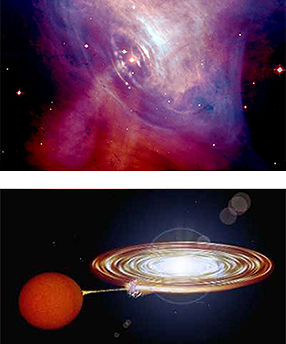The top photo shows the nuclear process on a neutron star. The bottom picture is an artist rendering of novae.
Astrophysics
Nuclear physics and astronomy are inextricably intertwined. The detailed properties of atomic nuclei, 100,000 times smaller than atoms, determine the chemical composition of the universe and the nature of stars. Many of the critical nuclei are short-lived rare isotopes, which decay within fractions of seconds. They are created briefly in stellar explosions serving as stepping stones for reactions creating new elements, and they also make up the crust of neutron stars where the extreme dense environment inhibits their decay. At NSCL some of these very same nuclei can be studied, and the signatures of their properties can then be found in the composition of our solar system and in stellar explosions observed with X-ray, gamma-ray, optical, neutrino- and, possibly in the near future, gravitational-wave observatories. By combining nuclear experiment, nuclear theory, astrophysical models, and observations we address open questions concerning the origin of the elements, the engines of stars and stellar explosions, and the nature of dense matter.
NSCL is a core institution of the Joint Institute for Nuclear Astrophysics Center for Evolution of the Elements (JINA-CEE).
Research on the origin of the elements in nature focuses on astrophysical processes with rare isotopes that have created many of the elements found on earth and in stars. We produce these very neutron rich, or very neutron deficient rare isotopes in the laboratory, determine their properties and decays, and have them undergo the same reactions that occur in stellar environments. The data are then used in computer simulations of stellar explosions to understand the buildup of new elements. Researchers in these areas are: Hendrik Schatz, Artemis Spyrou, Sean Liddick, Chris Wrede, Luke Roberts.
Novae and X-ray bursts research focuses on measuring the nuclear reactions that power these stellar explosions in the laboratory using fast, stopped, and reaccelerated beams. Nuclear theory is developed to predict reaction rates and to interpret nuclear reaction measurements. X-ray burst and nova computer models are used to link results to observations and to guide future experiments. Researchers in these areas are: Hendrik Schatz, Chris Wrede, Alex Brown, Ed Brown, Filomena Nunes.
Supernova research includes experiments with charge exchange reactions. The data guide work in nuclear theory to better predict these interactions. Massive star core collapse and thermonuclear supernova computer models identify critical nuclear physics, determine its impact on astronomical observations, and seek to identify the still unknown explosion mechanism. Researchers in these areas are: Remco Zegers, Alex Brown, Wolfgang Bauer, Ed Brown, Sean Couch, Luke Roberts.
Nuclear Processes in Stars are not well known because reactions are too slow to be measured directly. Research includes calculations of helium fusion at low temperatures, and studies of how our lack of knowledge of nuclear reaction rates affects the lives of stars and elements created. Researchers in these areas are: Filomena Nunes.
Neutron star studies focus on measurements of the pressure of nuclear matter in heavy-ion collisions on advancing the theory of nuclear matter, and on observational measurements of neutron star masses and radii. Model calculations of neutron star crusts make use of experimental and theoretical nuclear data on very neutron rich nuclei obtained at NSCL and elsewhere. Researchers in these areas are: Betty Tsang, Bill Lynch, Pawel Danielewicz, Hendrik Schatz, Alex Brown, Ed Brown, Luke Roberts.




